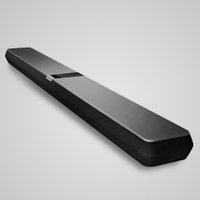TechRadar Verdict
The Samsung HW-800B hits you with really impressive Dolby Atmos positional audio from an impossibly slight soundbar. Going small does put some limits on the sound and means you lose out on some desirably features, but as a solution for people with low TV stands, it's unbeaten.
Pros
- +
Strong Dolby Atmos height and sound positioning
- +
Great sound balance overall
- +
Riduculously small physical volume
Cons
- -
No HDMI passthrough or eARC
- -
Mid-range struggles at times
- -
Lots of controls, but no screen
Why you can trust TechRadar
Samsung HW-S800B: Two-minute review
To read this Samsung HW-S800B review is to discover a problem solver. And the problem is size. In their efforts to look cool and minimalist, some TVs keep their screens very low on their stands. This is great, unless you want a big beefy soundbar, because when it sits in front of the TV, it can end up cutting off the bottom of the screen from your view when you're sitting on the sofa. This isn't a hypothetical – it's exactly the situation this reviewer has been in.
But the Samsung HW-S800B cancels this problem. Its whole trick is that it packs in multiple speaker angled speakers and big sound to rival the best soundbars, but the soundbar is approximately a quarter of the physical volume of the class-leading Sonos Arc. That's supplemented by a fairly small subwoofer, to add the low-end grunt that a compact soundbar unit can't.
It's fully equipped for Dolby Atmos (including upfiring drivers), and actually ranks really strongly for delivering that positional audio. Overhead sounds really come from the ceiling, and effects have convincing width and motion across the screen.
The overall sound quality feels borderline impossible for such a slim bar when compared to much bigger units, and the sub helps by providing a controlled but impactful low-end. Compared to similarly priced but bigger units, the mid-range is a little less dynamic, but if you want something this small, nothing does it better.
The features are where it gets a bit weird. You've got Bluetooth and Wi-Fi for music streaming, and with Samsung TVs it supports totally wireless communication with the TV and Samsung's Q-Symphony feature (if your TV is compatible with these)… but because of its small size it not only doesn't support HDMI passthrough (a shame at this price), but it also an unusual mini-HDMI connector. It comes with a cable, mercifully, but it means it doesn't support lossless HDMI eARC sound. There's also no optical connection.
So it has its quirks, and its limitations, but we were blown away the scale of the sound that this super-svelte soundbar spits out.
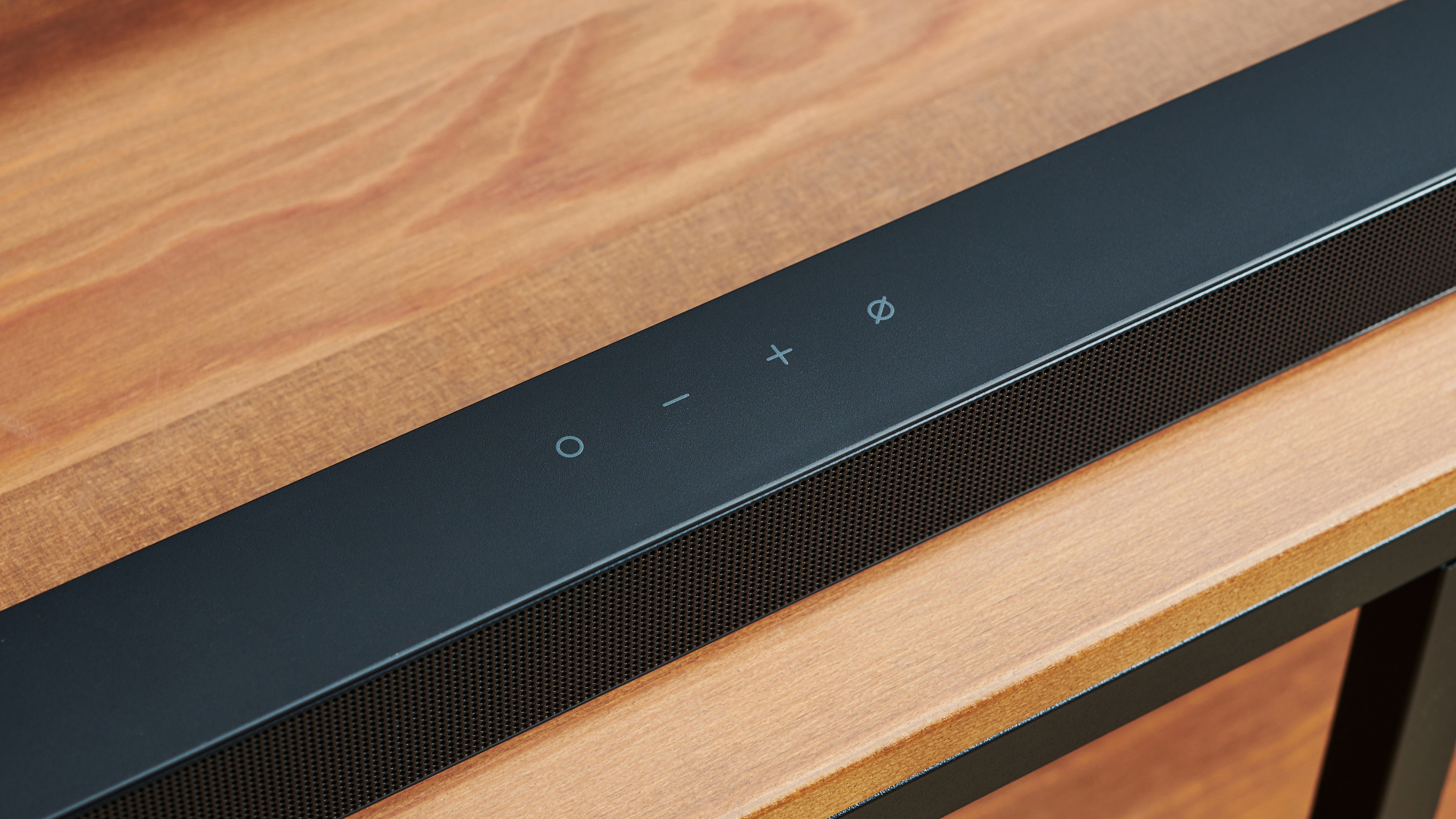
Samsung HW-S800B review: Price and release date
- Released in June 2022
- $899 / £749 / AU$999
The Samsung HW-S800B was released in summer 2022, and with a price of $899 / £749 / AU$999, it's targeting the more premium end of the soundbar market.
The price puts it in line with the Sonos Arc, which is a perfect example of the kind of hefty, tall soundbar the HW-S800B is trying to offer you an alternative to. It also tells you a lot about the kind of quality Samsung is overall aiming for with the audio here, which it largely nails.
There's not much that's a direct competitor to the S800B in terms of being so small, but the biggest danger probably comes from Samsung itself: the Samsung HW-Q800A is only a little taller, and also comes with a subwoofer and Dolby Atmos support, but is now available for around $600 / £550.
Samsung HW-S800B review: features
- 3.1.2-channel Dolby Atmos and DTS:X sound
- Mini-HDMI connector only – no optical, no passthrough, no eARC
- Bluetooth and Wi-Fi streaming, plus Samsung-specific features
The S800B is designed to deliver 3.1.2 channels of Dolby Atmos or DTS:X audio, which means front, center and right sound, the subwoofer bass channel, and two upfiring Dolby Atmos channels.
To do this, it includes eight separate speaker drivers in the soundbar unit, and another two in the subwoofer. That's a huge number for the amount of space it takes up, and it explains the quality of the directional audio.
As mentioned above, physical audio connectivity is limited to the mini-HDMI connector – there's no optical connector, and no HDMI passthrough. It also means that there's only HDMI ARC support, and not eARC. This means that it only takes a more compressed, 'lossy' version of Dolby Atmos sound rather than the full lossless Dolby Atmos that eARC supports.
Depending on your source, this may not be much of a problem – the Dolby Atmos version used by streaming services is 'lossy' anyway, so not having eARC isn't the end of the world. But if you love 4K Blu-rays for their maximum fidelity, which offer lossless Atmos sound, you don't quite get the best of them here.
Other ways to get sound over to the S800B include Bluetooth, and if you fire up the Samsung SmartThings app, you can connect the soundbar to your Wi-Fi network, enabling Apple AirPlay 2 and Spotify Connect streaming (but no Google Cast). It also has Alexa built-in, including a mic, so it functions fully as a smart speaker.
I had a problem where it didn’t show up consistently as a Bluetooth target on my iPhone, despite being connected in the Bluetooth settings, but it's hard to know whether to blame Apple or Samsung. It was frustrating, either way.
It has multiple listening modes, including a Night Mode for capping how loud things can be, a DTS Virtual:X mode for upscaling stereo to 3D sound, and a Game mode, among others. It also includes Samsung's SpaceFit tech, which listens to the output of the soundbar and adjust it to compensate for any quirks caused by the layout of your room.
The subwoofer connects wirelessly to the main unit, and both units support wireless communication with compatible 2022 Samsung TVs, as long as both are on the same Wi-Fi network, so you wouldn't need an HDMI cable at all.
It also works with Samsung's Q-Symphony feature, where the soundbar and TV speakers work in tandem to create an even larger sound field.
You can add Samsung wireless rear speakers in the future, if you want to create a full surround sound system.
- Features score: 4/5
Samsung HW-S800B review: sound quality
- Superb Dolby Atmos movement and height effects
- Mid-range struggles when it's busy
- Controlled yet rich bass
If you're looking for a relatively discreet soundbar that still provides a showpiece Dolby Atmos experience, this is absolutely it. There's width, there's height, there's movement in scenes… it really makes the most of object-based audio.
It's a very well-balanced sound too. We were worried that the small soundbar wouldn't be capable of moving enough air for a convincing lower-midrange, meaning that it and the subwoofer wouldn't smoothly integrate, but this wasn't a problem – the sound feels perfectly full and blends neatly between the two units. Having said that, we weren't totally wrong to be suspicious of the mid-range, but we'll come back to that in a moment, because we're still enjoying how prominent the Dolby Atmos effects are.
During Kylo Ren’s flyby of the bridge in The Last Jedi, the familiar TIE whining noise streaks from left to right near the top of the TV, and then the metal of the ship rumbles and creaks from the after-effect with convincing menace, thanks to the subwoofer. In the Crait battle at the end, the Millenium Falcon arrives with a shadow on the screen, but the engine howls from right up on your ceiling.
This height effect is better than you get from the similarly priced Sonos Arc, which struggles to put the sound right on the roof. The S800B nails it right to the ceiling just in front of you, though.
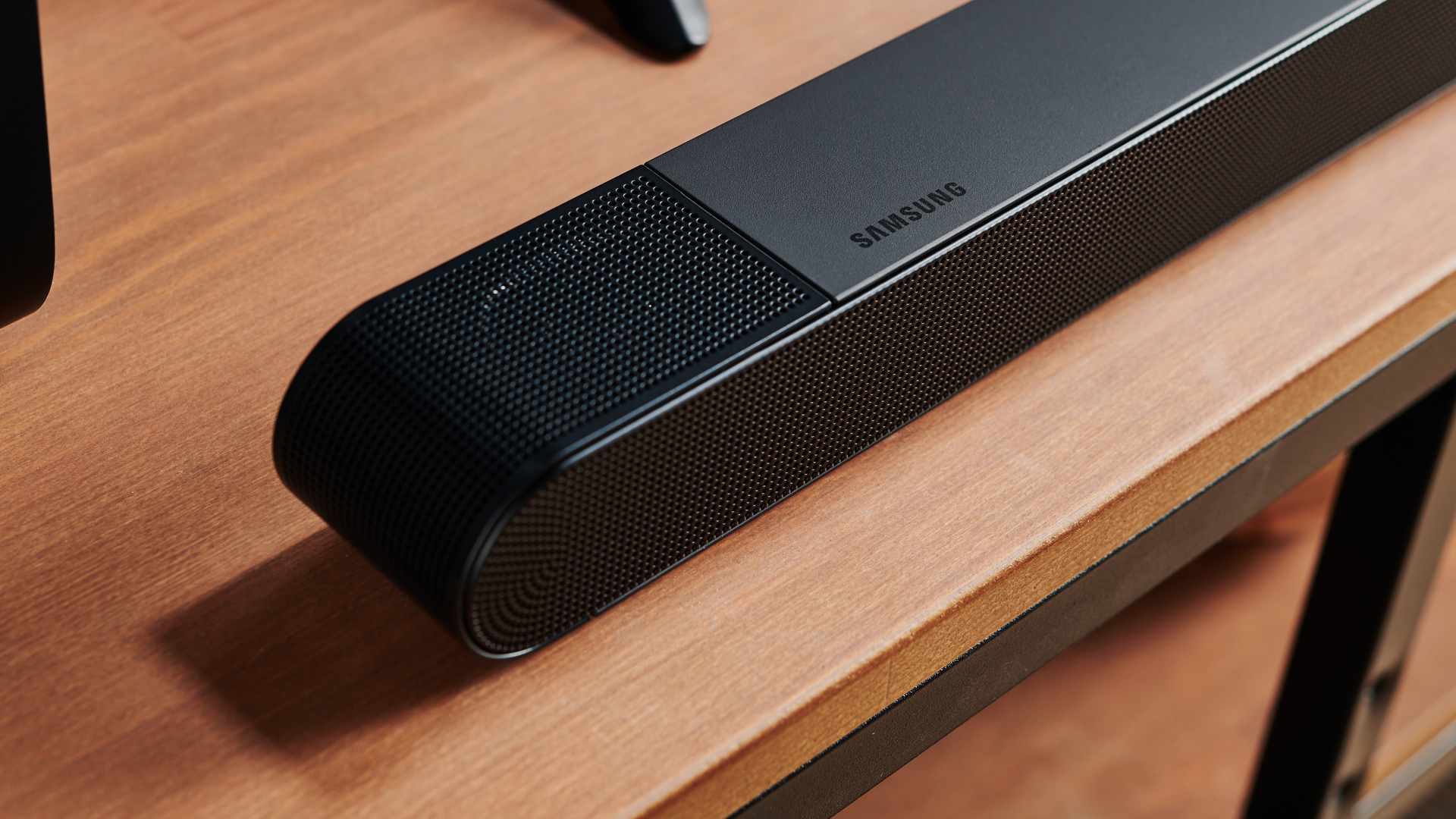
It also bests the Sonos Arc when it comes to bass, simply because it has a subwoofer and the Arc doesn't, and there's no substitute for a proper sub (well, except for the Devialet Dione, but that's a special case).
The gentle rumble of Kingpin's machine in Into The Spider-verse really shows the subtle power of a subwoofer. Without being loud and without shaking the room, it makes clear the scale of the giant spinning machine as the sub gently thrums in the corner, in a way that a single-unit soundbar can't really match.
When the machine explodes minutes later, the sub adds the meat to the sound, but the noise of the shockwave races out of the screen and right over you thanks to the subwoofer. In films that make the most of it, it's a thrill.
In the most extreme bass-heavy scenes, the sub can feel like it's knocking on your ear a little more, but the remote makes it easy to quickly dial it back if needed (and then you can reset it to normal with just a button-press, smartly).
However, as alluded to above, the S800B isn't perfect. In dense, music-led movie soundtrack moments, it can feel weaker than the likes of the Sonos Arc, or other big Samsung soundbars. It seems to just lack the space to be as dynamic as others can – sometimes prominent speech and busy music feel tied together, neither popping as much as it ideally would. The effect is most prominent when someone is yelling over an energetic soundtrack – the yelling is slightly swallowed into the mix, almost like the actor wasn't giving it their all.
With more ambient music, speech is very clear and precise, so it's not a clarity issue more generally.
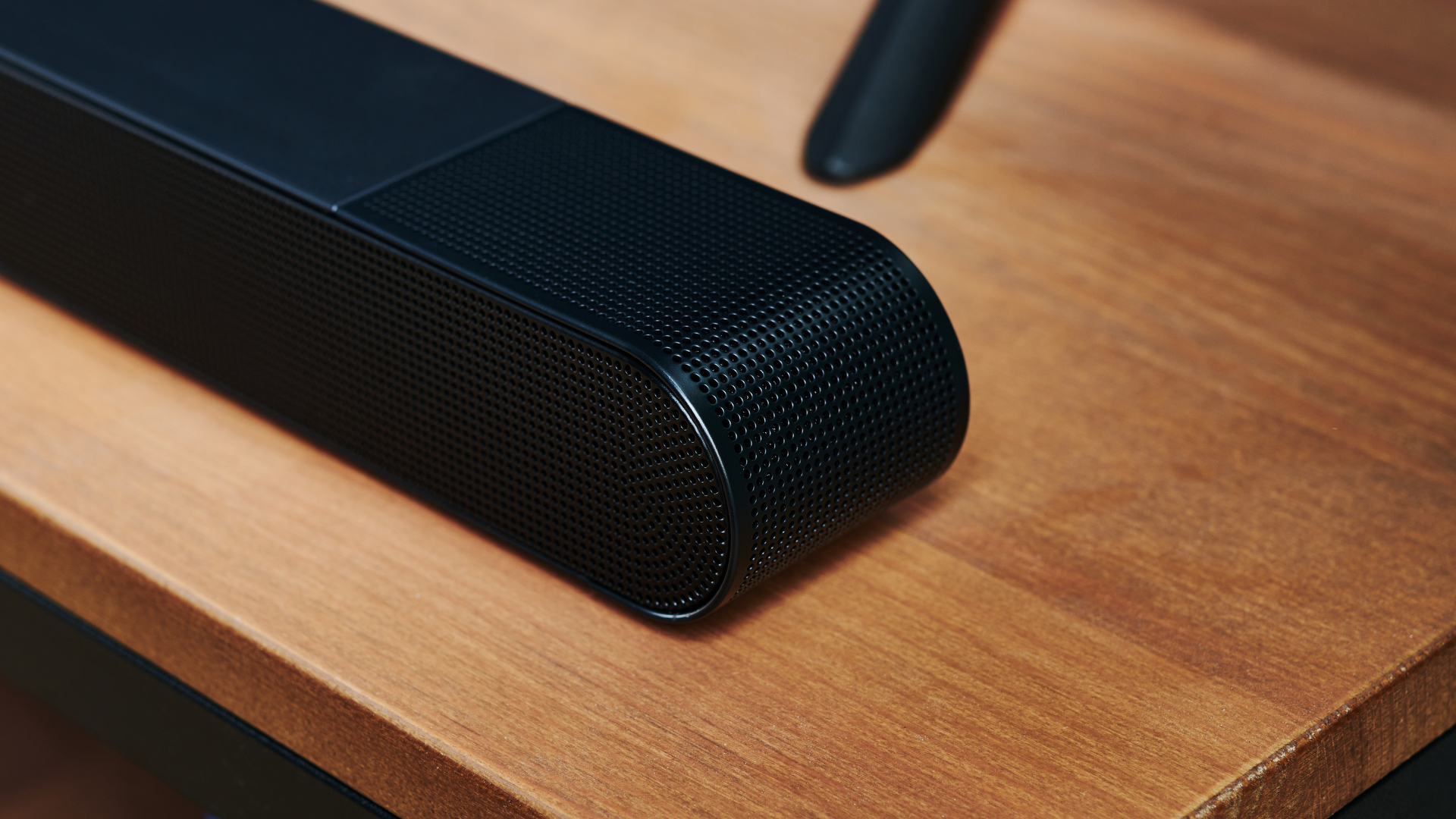
Treble-led effects especially always lift right out of the mix – in some cases, this just serves to make it even clearer when the mid-range struggles to quite do the same. But the strong treble adds prominence and thrills in many cases – a brighter and sharper effect to gunshots, laser fire or the a door slam.
Of the multiple sound modes, we were generally happiest with 'Standard' (the plain, no-fussin' mode) or 'Adaptive', which tweaks the output based on the type of content it detects. 'DTS Virtual:X' generally felt hollow and unnatural, and the 'Surround' mode for a "wider" sound field just felt unnecessary. The 'Game' mode also didn't generally feel necessary.
The S800B also isn't bad with music – it doesn’t have a music mode, but I enjoyed the standard mode fairly well. However, it doesn’t have quite the same rhythm and energy as the Sonos Arc for music, which is almost certainly down to that slightly tight mid-range.
- Sound quality score: 4/5
Samsung HW-S800B review: Design
- Ridiculously small volume, but wide
- All solid grille down the front
- Subwoofer is compact, too
We may have mentioned this already, but the Samsung S800B is small. Very small. In two dimensions, at least. With dimensions of 1160 x 38 x 40mm / 45.7 x 1.5 x 1.6 inches for the soundbar, it's as wide as the biggest of them. You'll need a TV of 55 inches or larger for this – it will stick out past the edges of anything smaller.
As part of keeping the subwoofer small, there's actually an external power box, which is unusual for products like this. It's no problem, but will want hiding away.
The subwoofer is less obsessed with being tiny, but is still impressively compact at 238 x 240.8 x 238 mm / 9.4 x 9.5 x 9.4 inches – we had no problem just dropping it into a space next to a TV stand without needing to rearrange our setup.
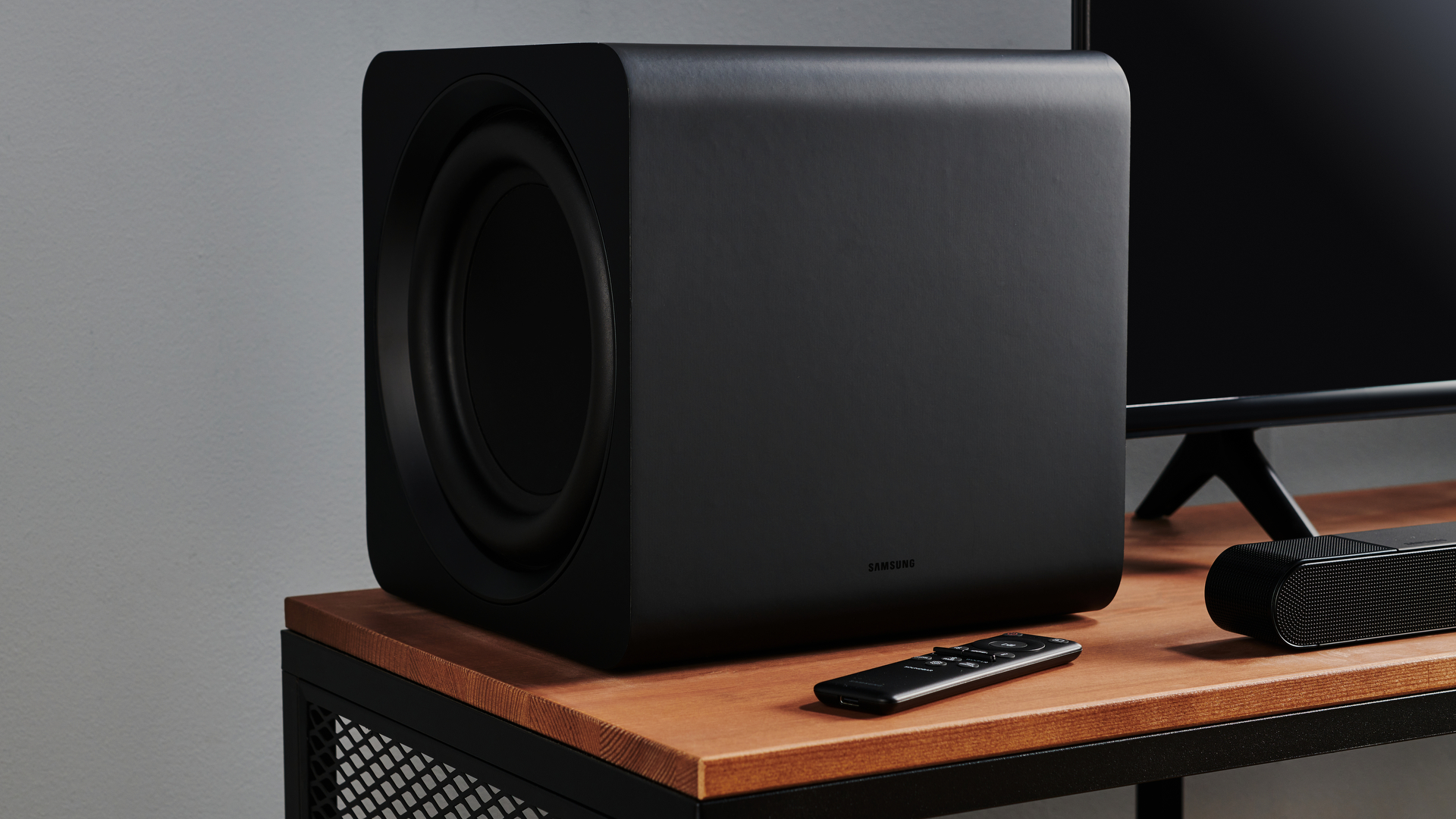
The outside of the soundbar is basically all dark grey grille on the front and sides, with another little grille section on top at each end for the upward drivers. Under the grille on the front is a set of four LED lights, which are used to indicate when you change modes, or change the volume. We'll come back to that in a moment.
The subwoofer is black, and has exposed drivers with no protective grille or cover included.
We think both units are pretty good looking, but equally are both so discreet that it doesn't matter too much if you're less keen.
The power and HDMI connection on the soundbar are separate, and both are side-angled inputs. They're easy to find if you need them.
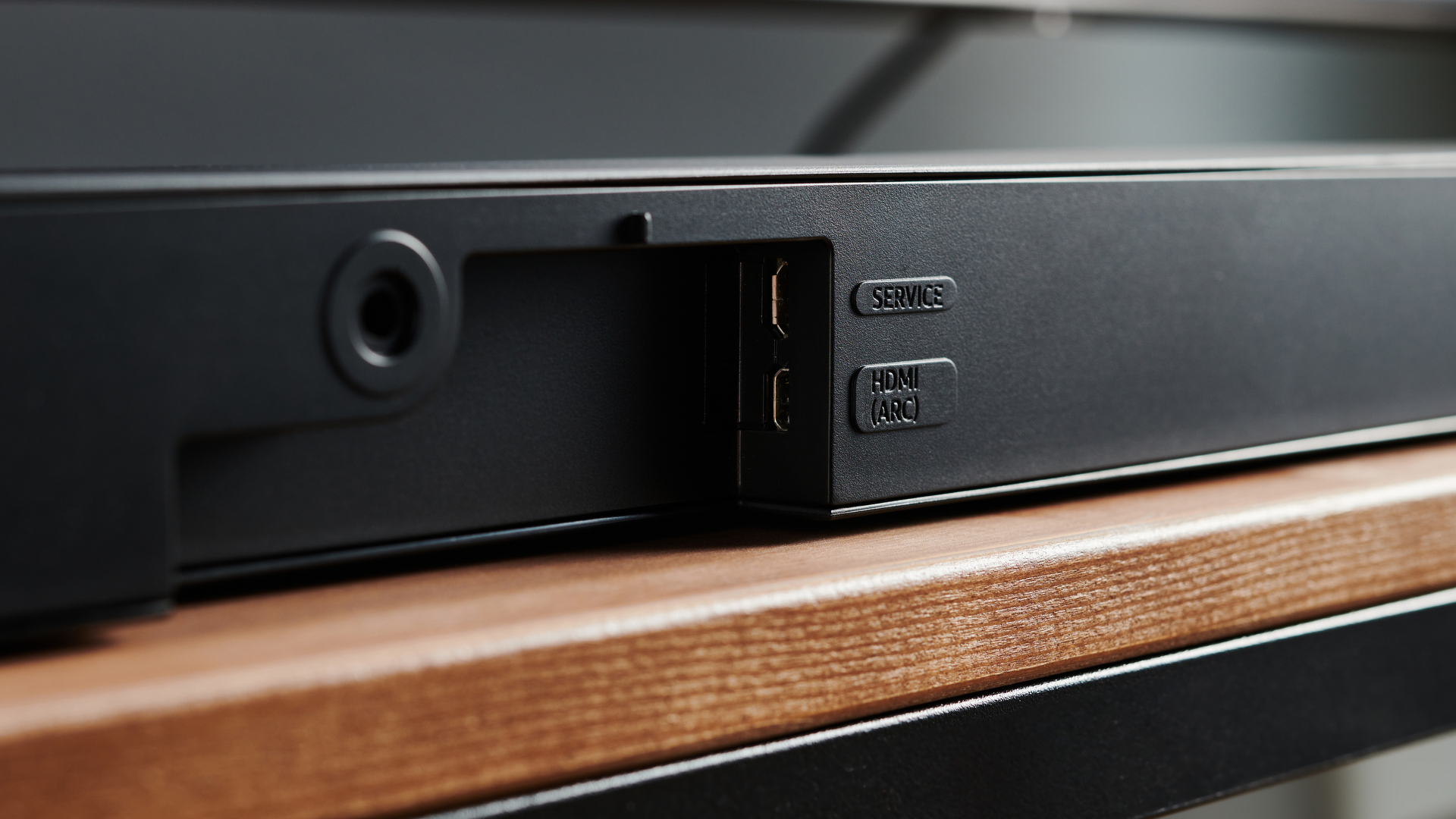
The remote is a black unit with a surprising number of buttons for such a theoretically simple device as a soundbar. The soundbar supports HDMI CEC, so you probably won't generally need (or want) to use the volume control here, but you also have the ability to increase or decrease the subwoofer's contribution. You've also got buttons for various sound modes, though knowing quite what you're doing isn't always easy. Let's talk about that.
- Design score: 4/5
Samsung HW-S800B review: Usability and setup
- Perfect HDMI ARC plug-and-play simplicity
- Requires app to set up Wi-Fi
- No screen, so you need to understand dots
Setting up the Samsung HW-S800B just for working with your TV is as easy as it gets: plug it into the wall, plug it into your TV, and plug the subwoofer in separately. You're straight off, with the two units instantly syncing wirelessly, and TV sound coming straight over HDMI ARC.
To get a device connected to it over Bluetooth, you'll need to use its own remote, and hit the pairing button usefully located right there. That was instant for us. And then, if you want to connect it to the Wi-Fi, you need to use the Samsung SmartThings app, which will walk you through the process – so it becomes a bit of a multi-stage thing. We had a problem with the app that on one network, we couldn't get it to connect, and there was no clear problem. We could tell if the problem was with the soundbar, the app, or the network itself being a pain – some transparency from the app would have helped.
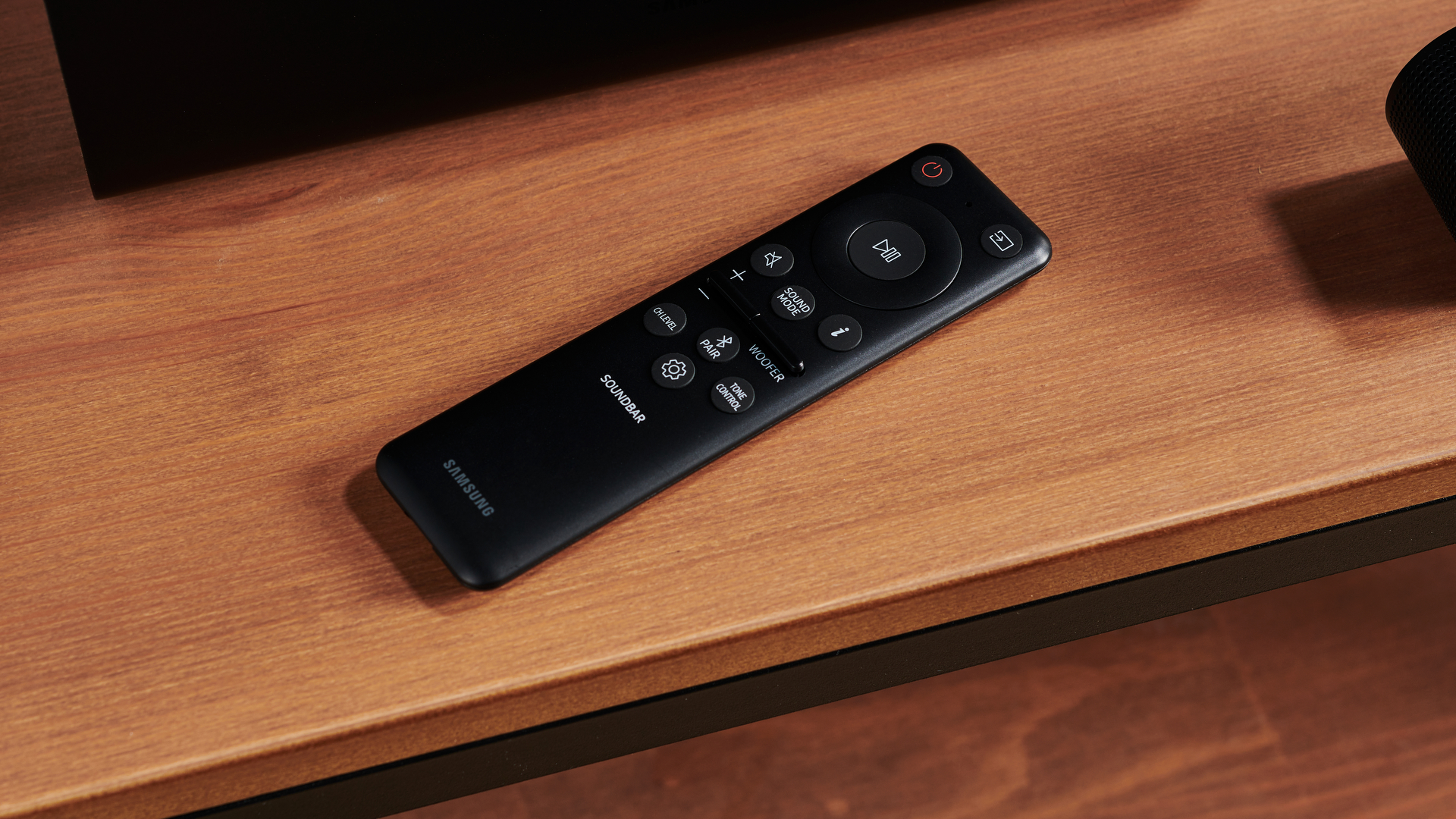
We've mentioned that the soundbar's remote has lots of buttons, and using them to change modes can be quite hit and miss. Part of the problem is that the soundbar doesn't have a screen, but instead a series of dots that flash in different colors and patterns to indicate things, which is… not something I'm ever going to learn. While trying modes for the review, I was sitting with the manual open on my lap, looking at diagrams of dots and flashes like I was trying to defuse a particularly whimsical bomb.
When you cycle through modes, you get a voice announcement as to what each one is, which is nice and clear. But when you cycle through options that can be turned on an off, it feels much less clear – including what you press to turn it on or off. It's all understandable with the manual and some time, but it's not what we'd call intuitive. Of course, if you don't plan to mess with the modes much, you won't need to worry.
- Usability and setup score: 3/5
Samsung HW-S800B review: Value
- Compares well to similarly priced soundbars
- Can still get most of the performance for less
The S800B is comfortably at the more premium end of the soundbar market but it mostly delivers the sound and features to match. Yes, we'd really prefer it to include an HDMI passthrough port, but it's not alone in lacking this feature at this price, so we won't judge it too harshly – especially when it's designed for people with a different priority in mind.
It's a similar story with the sound. It does feel like a mild compromise on sound quality in the mid-range to get the soundbar to be this small, but it's only a minor one, and we think it's comfortably balanced out by just how effective its Dolby Atmos height and positioning is.
This is made for people who want a premium soundbar that won't dominate their TV setup, and delivers that, but with audio that feels like it's at a much larger scale. We think it's competitive with soundbars at the same kind of price in that regard – but make no mistake that you can get fairly close to its sound quality from something much cheaper, if you can go a bit chunkier.
- Value score: 4/5
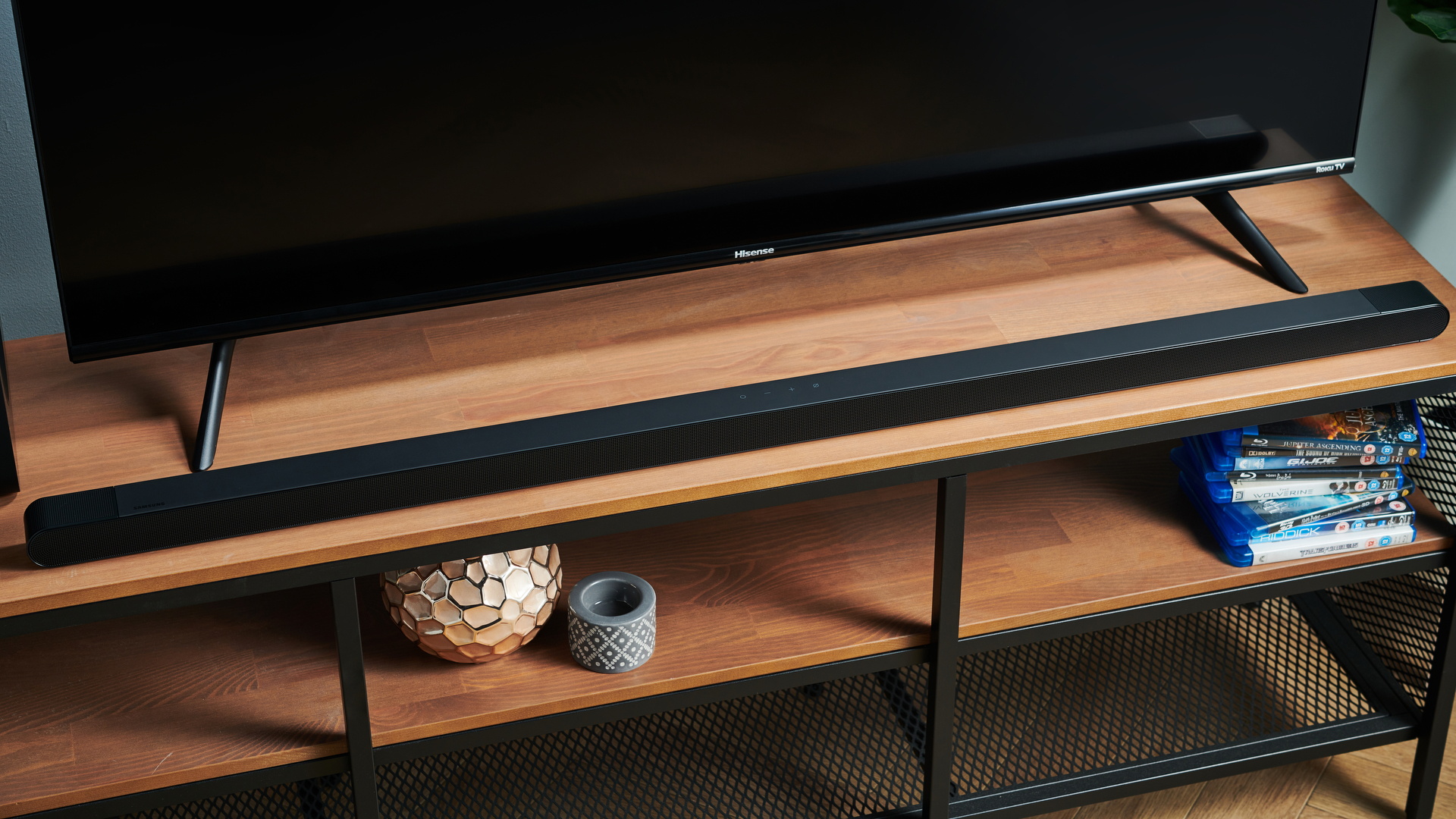
Should I buy the Samsung HW-S800B?
| Attributes | Notes | Rating |
|---|---|---|
| Features | No HDMI passthrough or eARC, but great for other features | 4/5 |
| Sound quality | Dramatic Dolby Atmos height and positioning, and well balanced. Slightly constrained in the mid-range. | 4/5 |
| Design | Ridiculously small, though still wide. Simple design – it looks nice, if not dazzling. | 4/5 |
| Usability and setup | Easy to set up with your TV, but could do with a screen to help you navigate the remote's options. | 3/5 |
| Value | Balances well against other premium soundbars at this price, especially when you consider the size. | 4/5 |
Buy it if…
Your TV has a low stand
This soundbar has a practical purpose, and that's to get out of the way if your TV's stand isn't tall. And it does that without losing striking Dolby Atmos sound.
You want to hear fancy Dolby Atmos effects
The height channels here are better than some pretty high-end competition, and the way sound are positioned in space in front of you is great. It really showcases Atmos.
You have a recent Samsung TV
With Samsung's 2022 TVs, you get totally wireless sound transmission, so you don't even need to use its mini-HDMI port. And with Samsung TVs from 2020 on, you can use Q-Symphony to combine soundbar and TV into one big soundscape.
Don't buy it if…
You want maximum fidelity
The sound quality here is impressive, but it's not as expansive in the mid-range as some competition, and there's no eARC for lossless Dolby Atmos.
You need HDMI passthrough
You will lose the use of one HDMI port on the TV when using this soundbar, so if you're tight on them, you might want something that can still pass through the video from a another connected device.
Your TV is smaller than 55 inches
It's small in some ways, but it's still wiiiiiide.
Also consider
Samsung HW-Q800A
It's a bit taller than the S800B, but not by too much, at 60mm high and 115mm deep. It's also less wide, and so works with TVs of 48 inches and up… but it's still 3.1.2 channels of Dolby Atmos goodness. And it's significantly cheaper than the S800B.
Bowers & Wilkins Panorama 3
This is a single-unit soundbar, meaning no subwoofer at all – bass is built into the soundbar unit. Most premium soundbars like that are pretty tall and chunky, but this keeps its height down to a reasonable 65mm, so it's the bar most suited to TVs with shorter stands, for people who don't want a sub.
- First reviewed: June 2022
- How we test: read TechRadar's reviews guarantee

Matt is TechRadar's Managing Editor for Entertainment, meaning he's in charge of persuading our team of writers and reviewers to watch the latest TV shows and movies on gorgeous TVs and listen to fantastic speakers and headphones. It's a tough task, as you can imagine. Matt has over a decade of experience in tech publishing, and previously ran the TV & audio coverage for our colleagues at T3.com, and before that he edited T3 magazine. During his career, he's also contributed to places as varied as Creative Bloq, PC Gamer, PetsRadar, MacLife, and Edge. TV and movie nerdism is his speciality, and he goes to the cinema three times a week. He's always happy to explain the virtues of Dolby Vision over a drink, but he might need to use props, like he's explaining the offside rule.


